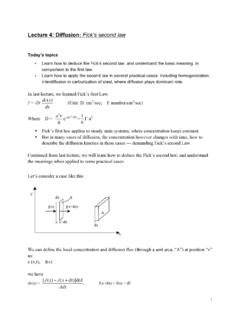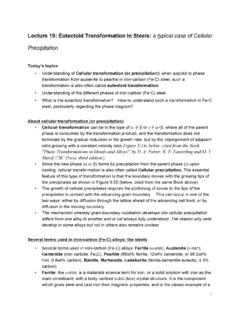Transcription of Lecture 8: Surface tension, internal pressure and energy ...
1 Lecture 8: Surface tension , internal pressure and energy of a spherical particle or droplet Today's topics Understand what is Surface tension or Surface energy , and how this balances with the internal pressure of a droplet to determine the droplet size. Why smaller droplets are not stable and tend to fuse into larger ones? So far, we have considered only bulk quantities of any given substance when describing its thermodynamic properties. The role of surfaces /interfaces is ignored. However, when the substance shrink in size down to a small droplet, particle, or precipitate, the effects of Surface /interface is no longer negligible, since the number atoms on Surface /Interface is comparable to number of atoms inside bulk.
2 Surface effects ( Surface energy ) play critical role many kinetics process of materials, such as the particle ripening and nucleation, as we will learn the lectures later. Typically, for many liquids and solid, Surface energy ( Surface tension ) is in the order of ~ 1 J/m2 (or N/m). For example, for water under ambient conditions, the Surface energy is J/m2 (or Surface tension of N/m). Think about a large oil droplet suspending in a cup of water: shake the cup, the oil droplet will disperse as many small ones, but these small droplets will eventually fuse together, forming back to a large one if let the cup stabilize for a while. This is because the increased Surface energy due to the smaller droplets (particles), fusing back to one large particle decreases the total energy , favorable in thermodynamic.
3 Essentially every phase transformation begins with the formation of a tiny spherical particle called nucleus. The Surface /interface separating the two, the particle and the matrix, is characterized by the existence of Surface energy (around J/m2 or erg/cm2). Note: unit of energy in cm-g-s unit system is erg, 1 erg = 10-7 J. It is thus necessary to account for the existence of the Surface when defining thermodynamic quantities. In case of a liquid droplet, there is a pressure inside the droplet. Similarly, this is true for a nucleus (precipitate as a solid particle). This pressure can be given in terms of the Surface energy (J/m2) or Surface tension (N/m).
4 P . P 1. Consider a free-body diagram for a half-sphere of a particle (or soap bubble) as shown above: radius is r, and circumference (at equator) is 2п r. P is the internal pressure relative to the outside pressure . is Surface energy . Surface tension force acts parallel to the particle's (bubble's) Surface , and is distributed around the perimeter of the cross section, as shown by the downward arrows in the diagram above, which can be calculated as Surface tension timing the perimeter, 2п r. The internal pressure of the particle (bubble) causes upward force, acting on the cross section area, and can be calculated as P п r2. These two forces are in balance.
5 Then, We have: P п r2 = п r 2. So, P = 2 /r (1). --- this is the simplified form of the Young Laplace equation. In physics, the Young Laplace equation describes the equilibrium pressure difference sustained across the interface between two static fluids, such as water and air, due to the phenomenon of Surface tension . From eq. (1), the smaller the size (radius), the higher the internal pressure . For example: This table shows how the internal pressure of a water droplet increases with decreasing radius. For not very small drops the effect is subtle, but the pressure difference becomes enormous when the drop sizes approach the molecular size.
6 Data obtained under standard conditions of temperature and pressure : 100 kPa (1 bar) and K (0 C). P for water drops of different radii Droplet radius 1 mm mm 1 m 10 nm P (atm) Note: the smaller droplets are not stable due to the higher pressure , thus tend to fuse into larger ones, as we can see as the morning dews, which are formed from the smaller ones. 2. At constant T d G = VA M d P VAM = molar volume of the substance Note: molar volume is the volume occupied by one mole of a substance (element, or compound). at a given temperature and pressure . Since the matter inside is under pressure , its chemical potential is higher than that under a flat Surface (for which the radius is infinite).
7 GA = GA (P) GA0(P0) = GA (r) GA0( ) P. P0. P M M. = VA dP = VA (P P0). P0. = VAM P. Where P0 = ambient pressure outside sphere, or the pressure corresponding to infinite radius substituting with Eq. (1), we have M. 2 VA. GA (r) GA0( ) = (2). r this equation can be written in the format of chemical potential M. 0 2 VA. A (r) A ( ) = (3). r In solution containing more than one species, above equation can be re-written as 2 Vi i (r) = i ( ) +. r where Vi is the molar volume of i, i ( ) is the chemical potential under a flat Surface . So, chemical potential is bigger in smaller particle, as Vi is always > 0. For precipitate in matrix of as shown below 3.
8 2 Vi . i (r) = i ( ) + (4). r . where r = radius of particle Vi = partial molar volume of i in . Eq. (4) implies --- The difference in chemical potentials, induced by a pressure difference, is the driving force for particle growth. More about Surface tension : (referenced from Wikipedia). Surface tension is an effect within the Surface layer of a liquid that causes that layer to behave as an elastic sheet. It allows insects, such as the water strider to walk on water. It allows small metal objects such as needles, razor blades, or foil fragments to float on the Surface of water, and it is the cause of capillary action. The physical and chemical behavior of liquids cannot be understood without taking Surface tension into account.
9 It governs the shape that small masses of liquid can assume and the degree of contact a liquid can make with another substance. Surface tension is caused by the attraction between the molecules of the liquid by various intermolecular forces. In the bulk of the liquid each molecule is pulled equally in all directions by neighboring liquid molecules, resulting in a net force of zero. At the Surface of the liquid, the molecules are pulled inwards by other molecules deeper inside the liquid and are not attracted as intensely by the molecules in the neighboring medium ( , vacuum, air or another liquid). Therefore all of the molecules at the Surface are subject to an inward force of molecular attraction which can be balanced only by the resistance of the liquid to compression.
10 This inward pull tends to diminish the Surface area, and in this respect a liquid Surface resembles a stretched elastic membrane. Thus the liquid squeezes itself together until it has the locally lowest Surface area possible 4.









